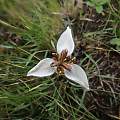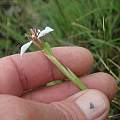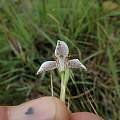The genus Moraea can be divided into five groups: Galaxia, Gynandriris, Hexaglottis, Homeria, and Moraea.
Moraea group species j-m are found on this wiki page. More information can be learned from Peter Goldblatt's book on Moraeas.
Moraea index lists all the species in all five groups alphabetically.
The other species in the Moraea group are listed alphabetically on these wiki pages: Moraea group a - Moraea group b - Moraea group c-e - Moraea group f - Moraea group g-i - Moraea group n-r - Moraea group s - Moraea group t - Moraea group u-v
Moraea lazulina Goldblatt & J.C.Manning is widespread in the Little Karoo where it is found on rocky sandstone ground and on limestone slopes. It has a solitary linear channeled leaf and large blue flowers with white nectar guides with each flower lasting a single day. It flowers in spring (September-October). It looks similar to Moraea exiliflora, but has larger flowers, always blue, with strongly reflexed tepals and is usually taller with a branched stem. The first two photos from iNaturalist were taken by Anne Lise Vlok in the Doornkloof Nature Reserve in the Northern Cape in October and shared under a CC BY-NC license. The third image is a drawing by John Manning shared with his permission from the Goldblatt and Manning paper naming eight new species. Figure notes: A, flowering plant; B, androecium and style. Scale bar: A, 10 mm; B, 2 mm.
Moraea lilacina Goldblatt & J.C.Manning is endemic to the Little Karoo where it grows on lower slopes in loamy soil. It is a slender plant growing to 30 cm with a narrow single leaf and a lilac-mauve flower with a yellow nectar guide. It flowers in spring. It can be confused with Moraea regalis but has smaller different colored flowers and shorter filaments. It is probably related to Moraea unguiculata. Photos below from the book Plants of the Klein Karoo courtesy of Jan and Anne Lise Schutte-Vlok.
Moraea longiaristata Goldblatt grows on rocky sandstone lower slopes in the southwestern Cape (Caledon Swartberg). Growing from 15 to 30 cm high, it has a single linear channeled leaf and small white flowers with yellow nectar guides outlined in dark blue with blue to purple speckles around and below the nectar guides, and long straight inner tepals. It's a small flower, but very elegant. It blooms September to October and is probably closely related to Moraea barnardii. You can see a nice photograph of the flower, along with more information, here. The first photo below was taken by Cameron McMaster. The next three photos from iNaturalist were taken by janeennichols in September near Caledon and shared under a CC BY-NC license.
Moraea loubseri Goldblatt is a winter growing species found on limestone and calcareous sand in the southwest Cape. It was discovered in 1973 by Johan Loubser, who found it on Olifantskop, in a site that had been partially mined for a quarry. It has never been found at another location. Although its site is now protected, its numbers are extremely small, and in the mid-2000s it was feared to be extinct. In 2013, a total of 14 plants with four seed pods were spotted by the Custodians of Rare and Endangered Wildflowers, a volunteer conservation group in South Africa. Fortunately, it is fairly easy to grow in cultivation with normal Mediterranean-climate treatment. This specimen was grown in Northern California and the first photograph below is from Bob Rutemoeller. The second was taken March 2004 by Lee Poulsen, the third by Bill Dijk and the fourth by Alan Horstmann. The last two photos by Michael Mace illustrate the bizarre coloration of Moraea loubseri. The center of the flower is translucent green, covered in glossy black hairs. At the outer edge of the translucent region is a deep blue nectar guide, also covered in hairs. The rest of the tepal is purple and mostly hairless.
Moraea lugubris (Salisb.) Goldblatt is found on mostly damp sandstone soils and it flowers in late winter into spring and has blue short lived flowers. The first photo was taken by Cameron McMaster near Darling on the West Coast. The next three photos were taken September 2003 by Bob Rutemoeller and Mary Sue Ittner in the Darling reserve, West Coast, South Africa. The fifth was taken by Bob Rutemoeller of flowering plants in Gordon Summerfield's collection. The corm photos were taken by Michael Mace.
Moraea lurida Ker Gawl. is a winter rainfall species that grows in rocky sandstone and granitic slopes in fynbos in the southwestern Cape. In the wild it blooms in spring, mainly after fire when the vegetation is cleared, giving it light. The flowers are said to be foul-smelling and are pollinated by flies. This species is easily grown from seed and multiplies rapidly. In drier parts of California, it seems to do better if given copious water, including possibly some water in summer to keep the corms from drying out too much. It blooms a bit later than the other spring-blooming moraeas, in late April-May. Photo 1 was taken by Mary Sue Ittner in northern California. Photo 2 was taken by Sheila Burrow from Western Australia. Photo 3 was taken by Audrey Cain from the UK. Photo 4 was taken by Nhu Nguyen showing the profile of the flower.
Although Moraea lurida flowers are usually reported in the shades of maroon and pale yellow shown above, in some areas they can be quite variable. These photos by Cameron McMaster show many different color forms seen near Napier and in the Overberg.
More photographs by Cameron McMaster
Maarten Groos, manager of a nature retreat called Farm 215 in the Southern Overberg, took these photos on the grounds of Farm 215:
More photographs by Maarten Groos
Moraea macgregorii Goldblatt is found on dry stony slopes wedged between rocks in the Vanrhynsdorp district. Growing from 12 to 25 cm high, it has a solitary narrow undulate leaf, a short, branched stem and pale lilac with golden nectar guide flowers. Tepal claws are unusually narrow. It flowers in October with flowers opening in the late afternoon and fading shortly after dark (about 3 hours). Photos from iNaturalist taken by Eugene Marinus in October, south of Nieuwoudtville and shared under a CC BY-NC license.
Moraea macrocarpa Goldblatt is found on the northwest Cape where it grows in deep sand in arid fynbos. It flowers in spring. It is 8 to 12 cm high and has short lived violet flowers with yellow nectar guides on the outer tepals. The first three photos from iNaturalist were taken by Campbell Fleming in September near Clanwilliam and shared under a CC BY-NC license. The last photo by Audrey Cain.
Moraea macronyx G.J.Lewis is found on rocky sandstone slopes in the Cape Province. Growing up to 15 cm tall, it has three hairy leaves and yellow and white short lived flowers with yellow spotted nectar guides and blooms in spring. The first four photos were taken by Bob Werra and the fifth by Michael Mace.
The first two photos are habitat pictures from the Komsberg in the Roggeveld. The first photo by Cameron McMaster and the second was taken in the same place September 2006 by Mary Sue Ittner. The last photo from the book Plants of the Klein Karoo courtesy of Jan and Anne Lise Schutte-Vlok.
The corms are unusual as they possess a pale spongy covering forming a criss-cross pattern. Within this outer covering a pearl-like interior is visible. The first photo is from Margaret Fox and shows small corms that are about 1 cm across. The second photo is from Michael Mace.
Moraea marionae N.E.Br. White has white to pale blue flowers, marked with lilac veins. The reflexed outer tepal limbs have deep yellow nectar guides at the bases; claws are speckled with purple spots on a broad median yellow band. It is a small plant, 20-30 cm tall, and often hidden in grass. Native to the summer rainfall part of South Africa, it flowers in the spring (at the start of the rainy season), with the leaf growing after flowering. It is similar to Moraea brevistyla, but that species is taller and more robust and flowers later. Photos from iNaturalist were taken in Ocotober on the east facing slope of Mount Anderson, Mpumalanga by Jimmy Whatmore.
Moraea modesta Killick grows in mountain grassland in Eastern Southern Africa including KwaZulu-Natal, the Eastern Cape, and Lesotho. It flowers early in the summer rainfall areas in spring before the rains have started and has small flowers that are white to pale mauve, veined or flushed purple on the reverse and with yellow nectar guides. It grows from 10 to 20 cm tall and flowers before the single leaf. The first photo by Cameron McMaster was taken in the Eastern Cape. The rest of the photos from iNaturalist were taken in the Eastern Cape by Brendan Cole and shared under a CC BY-NC-ND license.
Moraea muddii N.E.Br., a summer rainfall species, occurs in the higher grassland parts of the Amatola Mountains and in the northern parts of KwaZulu-Natal and up into Mozambique and eastern Zimbabwe. It is seldom taller than 40 cm, does not form clumps, and has a channeled narrow leaf 3-6 cm wide. Flowers are pale yellow with a darker yellow nectar guide. Habitat photos were taken by Cameron McMaster in the Eastern Cape. The last one was taken at Gaika's Kop.
Moraea mutila (C.H.Bergius ex Eckl.) Goldblatt & J.C.Manning is part of the Moraea tripetela complex. Information about the complex has been taken from the Goldblatt, Manning article. This species grows mainly in renosterveld from the Cape peninsula north to Piketberg and east to Tulbagh. Growing from 15–30 cm high, it has a solitary, linear foliage leaf, shallowly channeled below, often slightly twisted, shorter than the stem, even half as long. It has pale blue or white flowers, with white to pale yellow nectar guides with dark blue or purple spots. Inner tepals are more or less linear, or may widen into rounded lobes midway along their length, 7.5–12.5 mm long. Pollen is red or yellow. Flowering is early, late August to late September. Photos from iNaturalist taken by Jacques van der Merwe in the Western Cape in August and shared under a CC BY-SA license. Drawing by John Manning shared with his permission from the paper referenced above. Figure notes: A, flower; B, capsule; C, seeds. Scale bar: A, B, 10 mm; C, 2 mm.
Galaxia - Gynandriris - Hexaglottis - Homeria a-j - Homeria k-z - Moraea group a - Moraea group b - Moraea group c-e - Moraea group f - Moraea group g-i - Moraea group n-r - Moraea group s - Moraea group t - Moraea group u-v - Moraea hybrids - Moraea index


















































































